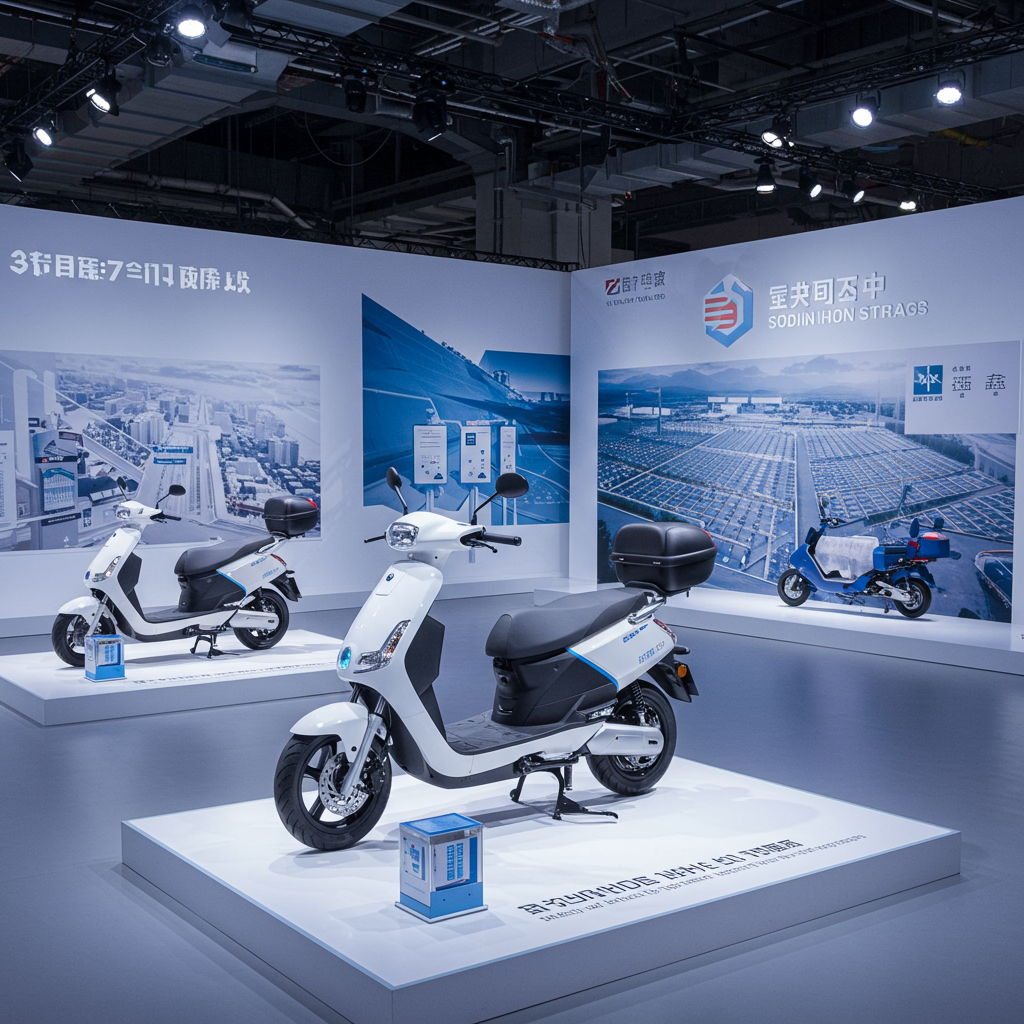China is at the forefront of bringing sodium-ion batteries, often dubbed “salt batteries,” to the mass market. While lithium-ion technology dominates the electric vehicle (EV) landscape globally, Chinese companies are aggressively pursuing this alternative chemistry, first seen powering ubiquitous electric scooters and now increasingly eyed for large-scale energy storage.
At promotional events in cities like Hangzhou, dozens of electric mopeds are showcasing the potential of this emerging technology. These stylish, Vespa-like scooters, typically priced between £300 and £500 ($400-$660), are ditching traditional lead-acid and even mainstream lithium-ion cells for batteries derived from sodium – an element vastly more abundant and accessible than lithium, easily extracted from sources like sea salt.
Accompanying these scooters are new charging solutions, including fast-charging pillars capable of replenishing batteries from 0% to 80% in as little as 15 minutes, according to major manufacturer Yadea. Battery swapping stations, allowing commuters to quickly exchange a depleted battery for a fresh one via a QR code scan, are also becoming part of the ecosystem. This push reflects China’s rapid advancements in clean technology and its strategic drive to build competitive advantages beyond existing lithium-ion dominance.
Why Sodium-Ion? The Strategic Edge
Sodium-ion batteries share a similar fundamental structure to lithium-ion cells but utilize sodium ions to shuttle energy. The key difference lies in raw material availability. Sodium is roughly 400 times more abundant than lithium, found widely in seawater and the Earth’s crust. This accessibility offers significant potential advantages:
Reduced Cost: Sodium’s abundance could lead to lower production costs at scale, freeing the industry from potential supply chain bottlenecks associated with lithium.
Supply Chain Resilience: It lessens dependence on regions where lithium mining and processing are concentrated (like Australia, Chile, and China).
Environmental Benefits: Sodium-ion batteries can avoid the use of heavy metals like cobalt and nickel, commonly found in some lithium-ion chemistries, reducing the environmental and human health impacts associated with their mining.
Improved Performance in Cold: Sodium ions move more easily through the battery’s electrolyte at lower temperatures, potentially offering better cold-weather performance compared to lithium-ion batteries.
Enhanced Safety: Some studies suggest sodium-ion batteries are less prone to overheating and combustion due to the inherent stability of sodium’s chemical properties, although more research is needed to definitively confirm long-term safety.
Interest in sodium-ion technology surged around 2021-2022 when battery-grade lithium prices skyrocketed. While lithium costs have since decreased, the initial frenzy highlighted the need for alternatives and solidified China’s focus on developing a resilient and diversified battery supply chain.
Electric Scooters: A Critical Launchpad
The electric two-wheeler market provides an ideal entry point for sodium-ion batteries. In China alone, approximately 55 million electric bikes and mopeds were sold in 2023, a volume nearly six times higher than all electric cars sold in the country that year. These vehicles, affectionately nicknamed “little electric donkeys,” are essential for daily commuting and errands in many Asian countries.
Critically, two-wheelers typically operate over shorter distances and at lower speeds than cars, making them less demanding in terms of battery energy density – a key limitation of current sodium-ion technology (at least 30% lower than lithium-ion). While this lower density hinders their suitability for long-range EVs, it’s less of an issue for scooters, where sodium-ion batteries can compete favorably against lower-performance lead-acid batteries, despite currently being slightly more expensive than lead-acid.
Companies like Yadea are actively driving adoption. They have launched multiple sodium-powered models and are investing heavily in associated charging and swapping infrastructure. A pilot program in Shenzhen involving 150,000 food delivery couriers is testing the efficiency of battery swapping, aiming for swaps within 30 seconds. Shenzhen is aggressively promoting itself as a “battery-swapping city,” planning tens of thousands of charging and swapping points by 2027 to create a dense, convenient network. Other players like Tailg and BYD’s battery arm FinDreams are also entering the sodium-ion space for two-wheelers, often partnering with established manufacturers. Market analysis projects a significant surge, with sodium-ion batteries potentially powering 15% of China’s electric scooters by 2030, up from a negligible share in 2023.
Beyond Mobility: Expanding Applications
While scooters are a vital mass-market segment, the application of sodium-ion batteries in China extends far beyond. Experts and industry insiders highlight fixed energy storage systems as potentially an even larger market for this technology.
For grid-scale energy storage stations, which absorb power from renewable sources like solar and wind to release it when needed, the weight and energy density limitations that affect vehicles are less relevant. As one expert put it, “You can just make a slightly bigger energy storage plant. It’s not moving anywhere. The weight doesn’t matter.”
The global demand for grid-scale storage is forecast to grow dramatically – needing a nearly 35-fold increase by 2030 to support net-zero goals, according to the International Energy Agency. China is leading the world in deploying energy storage for renewables, and sodium-ion is becoming a significant part of this strategy. Roughly one-fifth of the capacity in energy storage projects planned by China’s state-run companies last year utilized sodium technology. This includes pioneering projects like a 10 MWh sodium-ion station in Guangxi and another in Hubei province.
Furthermore, technological advancements are expanding sodium-ion’s utility to other areas requiring reliable backup or distributed power, such as data centers, telecom base stations, underground mining equipment, and construction vehicles.
China’s Unmatched Momentum
China’s rapid rise in sodium-ion batteries is underpinned by several factors:
Aggressive Investment: Chinese firms collectively invested over 55 billion yuan (£5.7bn, $7.6bn) in sodium-ion R&D in 2023 alone, dwarfing cumulative investments in non-lithium battery solutions in some other regions.
Speed of Commercialization: Chinese companies have demonstrated an exceptional ability to quickly transition technology from the lab to mass production.
Adaptable Infrastructure: The structural similarities between lithium-ion and sodium-ion batteries allow Chinese manufacturers to adapt existing production lines, significantly reducing the time and cost required for scaling up.
- Massive Scaling Plans: Chinese manufacturers announced plans in 2024 for 27 new sodium-ion battery plants with a combined capacity of 180 GWh. Projections suggest China will command over 90% of the global sodium-ion battery production capacity by 2033.
- https://www.bbc.com/future/article/20250530-how-electric-scooters-are-driving-chinas-salt-battery-push
- https://www.globaltimes.cn/page/202506/1335358.shtml
- https://illuminem.com/illuminemvoices/how-materials-science-innovations-will-take-us-to-a-cleaner-future
This strategic push is not merely about finding an alternative chemistry; it’s about maintaining global leadership in the burgeoning battery sector. While other countries are also pursuing sodium-ion, China’s rapid industrial deployment and massive scale are positioning its companies to dominate this future market, ensuring they don’t lose ground in the ongoing global energy transition.
Challenges and the Future Outlook
Despite the momentum, challenges remain. The lower energy density still limits sodium-ion’s direct competition with high-performance lithium-ion batteries in long-range EVs. Furthermore, achieving true cost parity, particularly for energy storage applications where unit costs are currently higher than lithium-ion, requires further technological refinement and economies of scale.
Nonetheless, the rapid development and diverse applications of sodium-ion batteries in China—from electrifying millions of scooters to bolstering the grid with large-scale storage—underscore its potential as a crucial, complementary technology in the global shift towards electric mobility and renewable energy. This push is driven by relentless technological innovation, expanding market opportunities, and a clear strategy to lead the charge in the next generation of battery solutions.




